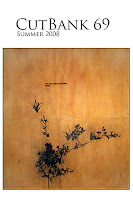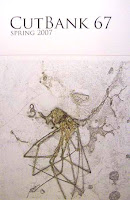
Coffee House Press, 2008
Reviewed by Kristina Marie Darling
Recently selected by John Yau for inclusion in the National Poetry Series, Donna Stonecipher's The Cosmopolitan presents a vision of travel that encompasses an exploration of one's surroundings as well as the discovery of new terrain within one's self. Written as ornate prose poem sequences in which quotes from other texts are often embedded, the works in this volume use their hybrid form to document the emotional and intellectual states that are evoked by place. Just as the miniature travelogues are structured around newly unearthed insights, Stonecipher's poems gracefully depict one's inner life as governing the ways one inhabits the world.
In conveying these themes, Stonecipher's use of such diverse texts as Franz Kafka's The Trial, Claude Levi-Strauss's Tristes Tropiques, and Thomas Mann's Doctor Faustus to illuminate her own work proves striking. Frequently presenting the reader with memorable quotes arrived at through various author's literary allusions, the poems offer their speakers' small epiphanies as literary journeys in themselves. A poem entitled "Inlay 2 (Elaine Scarry)," which uses text from Scarry's Dreaming by the Book, exemplifies this trend:
If only our troubles were those of the town planner. Our freshly prepared grid, where to position the park, the town hall, the elementary school, the bored housewife fucking the plumber? The town is a given. The town waits like a fate for the town planner, who slowly reveals it with a blue pencil.
'Daydreaming originates in the volitional' (15).
In this passage, the poet presents Elaine Scarry's statement as an insight arrived at through a journey of intellectual inquiry, suggesting that travel remains a dialogue between oneself and the literary and cultural texts evoked by a given place. As the piece unfolds, this travelogue of consciousness ultimately obscures the reader's ability to definitively locate the speaker, privileging one's ability to trace oneself emotionally and intellectually.
Likewise, other works in The Cosmopolitan question the extent to which one can journey through the world without unearthing an undiscovered aspect of self. In this respect, the poet establishes reciprocity between one's inner life and surroundings. She writes, for example, in "Inlay 6 (Mary B. Campbell),"
The group of students touring Chartres was told by the bespectacled guide that the stained glass pictures were not merely pretty, but actually scripture for the illiterate. Years later, one of the students would remember this while reading at a desk facing a window and think: What beauty isn't born out of the missionary position? (29)
Here Stonecipher forges unexpected connections between the character's memory of the cathedral and the manner in which he or she perceives future works of art. In many ways, the poet suggests that the character's past experience of Chartres enables and validates later insights about beauty and artifice. Like other works in the collection, "Inlay 6 (Mary B. Campbell)" depicts one's experience of place as complicating one's experience of self, suggesting that the two remain, in some respects, inextricable.
Moreover, Stonecipher uses this complex relationship between oneself and one's surroundings to offer incisive cultural commentary, highlighting the dissonance between one's inner life and the exterior world. Frequently juxtaposing the narrator's intellectual journeys with an increasingly commercialized travel culture, the poet often hints that a lucrative industry resides behind many individual's desire for such introspection and self discovery. She explains, for instance, in "Inlay 12 (Owen Jones),"
One loved; one did not love; goods changed hands. She was looking for the seed pearl dropped off the scale in the middle of the vast outdoor market. At the airport, he reached into his bag for his cyanometer — which of the fifty different kinds of blue was this particular sky? (50)
In this selection, just as the character in the poem attempts to empirically determine "which of the fifty different kinds of blue" that the sky is that day, characters recur throughout The Cosmopolitan who treat the world as a "conquerable entity," which can be subjugated through travel. Although acknowledging the prevailing (and frequently consumerist) approach to exploring one's surroundings, Stonecipher depicts her narrator as still "looking for the seed pearl" that has been lost amidst the commercial fanfare, striking an optimistic chord with the reader.
All points considered, Donna Stonecipher's new book is a meditative, philosophical read. The Cosmopolitan refashions the time-honored form of the prose poem while raising fascinating questions about travel and self-discovery. Highly recommended.
**
**
Kristina Marie Darling is a graduate student at Washington University in St. Louis. Eight chapbooks of her work have been published, among them Fevers and Clocks (March Street Press, 2006), The Traffic in Women (Dancing Girl Press, 2006), and Night Music (BlazeVOX Books, 2008). A two-time Pushcart Prize nominee, Kristina has also written on contemporary literature for The Boston Review, The Colorado Review, New Letters, The Mid-American Review, Third Coast, and other journals. Recent awards include residencies at the Vermont Studio Center and the Mary Anderson Center for the Arts.




